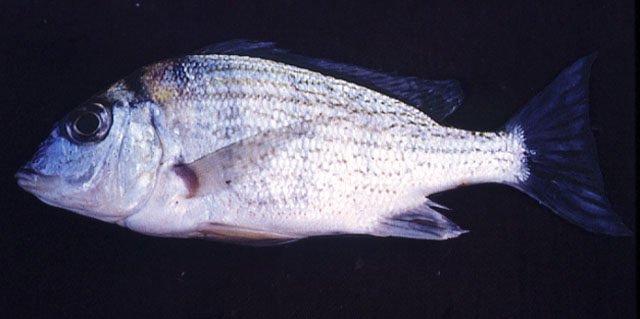| Cichlidae (Cichlids), subfamily: Pseudocrenilabrinae |
| 43.5 cm NG (male/unsexed) |
|
demersal |
| Africa: endemic to Lake Tanganyika (Ref. 5714, 52346). In the Lukuga River (Lake Tanganyika outflow), known up to Niemba (Ref. 93587). |
|
Dorsal spines (total): 14-16; Dorsal soft rays (total): 13-15; Anal spines: 3-3; Anal soft rays: 7-9; Vertebrae: 30. Diagnosis: high lateral line count (54-59 scales)(Ref. 52346). Scales small (Ref. 53244).
Description: body deep and narrow, laterally compressed, tappering off strongly toward the caudal peduncle (Ref. 6770). Relatively slender, although adults sometimes with very massive heads (Ref. 52346, Ref. 52307). Adult predorsal profile rises smoothly in a broad sweep to the origin of the dorsal fin although the line of the profile is often somewhat interrupted by a thickening in the interorbital region; deepest body depth lies at or a little in front of the dorsal fin origin; lower jaw usually inclined at an angle of about 10° to the horizontal when the mouth is closed; lower pharyngeal jaw extremely robust (Ref. 52346). Pharyngeal apophysis of the Tylochromis type (Ref. 53524). Large crushing pharyngeal teeth (Ref. 10616). Snout rounded (Ref. 52307). 4-5 series of scales on cheek (Ref. 2989). Larger scales on operculum (Ref. 45627, Ref. 1879). Hypobranchial with 2 simple elongate rakers, the following 4-5 ceratobranchial rakers usually widely spaced and non-overlapping, and the remaining lower limb rakers more closely spaced and overlapping; epibranchial rakers rather stout, elongate and closely packed; vertebral apophysis well-developed and robust, borne on the third vertebral centrum and usually lacking a major contribution from the fourth centrum, although in smaller individuals the fourth centrum may contribute a small buttressing component; 54-59 lateral line scales (Ref. 52346). 25-33 scales in upper lateral line, 41-48 scales in lower lateral line; 6-8 scales between dorsal fin and upper lateral line; 16-19 scales between lower lateral line and anal fin (Ref. 45485). Upper branch of lateral line terminates far in advance of the end of the dorsal fin, often as far anterior as the level of the last dorsal spine; terminal canal bearing scales do not descend scale rows; 3 rows of non-pored scales between upper and lower lateral line; dorsal and ventral branches of the lateral line on the caudal fin extend almost to the fin periphery while the median branch is less developed and often reaches only as far as about halfway along the fin; dorsal fin spines increase gradually in length to the fifth and are then more or less equal in length to the last four or five which are often slightly shorter than the preceding ones; anal fin rounded (Ref. 52346). Anal fin spines very strong (Ref. 2989). Pectoral fins long and even in juveniles extending to the level of the middle of the soft anal fin; first branched pelvic ray filamentous and often produced beyond the soft anal fin; caudal peduncle relatively long and thin (Ref. 52346). Caudal fin subtruncate (slightly forked) (Ref. 52307), strongly emarginate, and rather finely scaled even in large individuals; caudal scaling in juveniles restricted to the dorsal and ventral fields of the fin (Ref. 52346).
Coloration: greyish or brownish above, white below; with or without 5-7 inconspicious vertical bars; pale yellow or green longitudinal striations between scale rows; mature males have a caudal fin striated in the typical manner and a soft anal fin with 3-4 large non-occelate maculae; females and juveniles apparently without anal maculation, but with pale grey-brown fin membranes; nape stripe dark and prominent, but usually not in contact with the faint and diffuse opercular blotch; a red vertical stripe on the gill cover may be present, possibly restricted to mature males (Ref. 52346). Angle of the jaws, origin of paired fins and the tips of the anterior dorsal fin spines reddish; a number of dark brown dots on the dorsal fin (Ref. 52346, Ref. 52307). Juveniles less than 20cm do not display any of the colors of the adults (Ref. 6770). Juveniles less than ca. 12cm SL exhibit typical juvenile barring, with distinct dark vertical stripes interdigitated by pale and shorter stripes (Ref. 52346). |
| Swamp-dweller (Ref. 6770). Juveniles are coastal and gregarious while adults wander over the sandy bottoms by themselves (Ref. 6770), in shallow inshore areas of the lake, in lagoons and river mouths (Ref. 4967). Feeds mainly on crustaceans and insects, along with some plants (Ref. 52307), but also a mollusc eater (Ref. 10616, Ref. 6316). Female carries the eggs (Ref. 1872). |
|
(Ref. 96402)
|
| harmless |
|
Source and more info: www.fishbase.org. For personal, classroom, and other internal use only. Not for publication.
Page created by Jen, 05.08.02,
php script by kbanasihan 06/09/2010 ,
last modified by
dsantos, 20/08/10

